

On the designated day of our formal visit to the Mazar, we paid our parking dues and our per-person entry fees before proceeding to the main podium to pay our respects to the Quaid. Just before ascending the steps, a pan-muddled voice stopped us and asked us to take our footwear off, out of respect, and deposit it for safe custody — for a small charge, of course. For us commoners, there is a price to be paid for visiting the Quaid and an additional charge for being respectful to him. It’s hardly a surprise of course; we have successfully commercialised the Great Leader — even his title “Quaid-e-Azam” has been debased by us to the point where “Quaid-e-Azam ki sifarish” has become a euphemism for bribery!
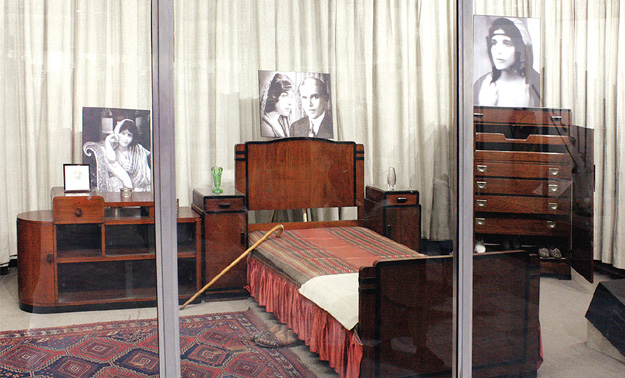
This is what the Quaid-e-Azam's bedroom looked like. The cane carelessly resting on the bed, it seems as if the great man has gone to get a drink of water and will be back any second.
From the Quaid’s tomb, we proceeded to visit those of some of his closest confidants, located in a roofed hall besides the podium. These include his sister, Ms Fatima Jinnah, Shaheed-e-Millat Nawabzada Liaquat Ali Khan and his wife Ra’na Liaqat Ali Khan, Sardar Abdur Rab Nishtar and Nurul Amin. The fact that Ms Jinnah was a dental surgeon and Begum Ra’na Liaqat was the brains behind the All Pakistan Women’s Association provides a good deal of insight into the mindsets of the nation’s early leaders. Sardar Sahib was a Muslim League leader and his claim to fame should be his achievements and services, not the common slogan “chalo chalo Nishtar park chalo” that we hear whenever a political party organises a jalsa in the park named after him. Nurul Amin was another Muslim League personality from the Bengal and a thorough patriot. He was sworn in as the first and only Vice President of Pakistan on December 22, 1971. A case of too little and a tad too late, one might say.

Treasures from history: Some of the Quaid's personal mementos.
The writing on Shaheed-e-Millat Nawabzada Liaquat Ali Khan’s grave is Urdu on one side and Bengali on the other, while on that of his wife, Begum Ra’na Liaquat Ali Khan besides his, is Urdu on one side and English on the other. Sometimes, seemingly minor details give away darker chapters of history that are usually brushed under the rug. One bitter December in 1971 is the difference between the two graves.
Not wanting to explain to a four year old the disappointments and horrors that surround the event, I made a quick exit from the hall before a question was raised regarding the script. How could I explain to my son this sad chapter of my nation’s history when I do not completely understand it myself?
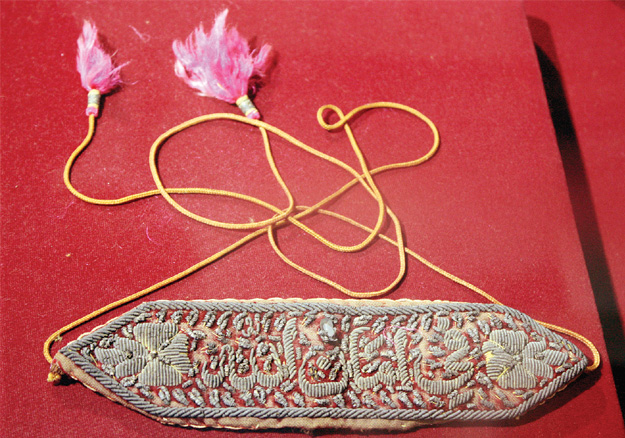
The Quaid's Iman Zamin
The “Aiwan-e-Nawadirat-e-Quaid-i-Azam”, which is a formal name in Romanised Urdu for the Quaid-i-Azam Museum, located adajacent to the hall housing the other graves, is a must-see. One has to pay an additional little charge here for getting a better glimpse into the life of the father of the nation — and judging by the upkeep of the museum, every paisa is worth it, many times over.

Jinnah's suits tailored in Europe
Unlike the Quaid’s principles, his belongings have been carefully preserved, after restoration where required, and placed in well-lit glass chambers. His collection of swords and firearms, some of them hand-made gifts, is placed behind a protective metal cage. Although photography is not allowed inside the museum, I had negotiated a special permission as I was writing for the press — but as I was to find out, the protective glass, iron cage and lighting in the hall is not designed to facilitate photography.
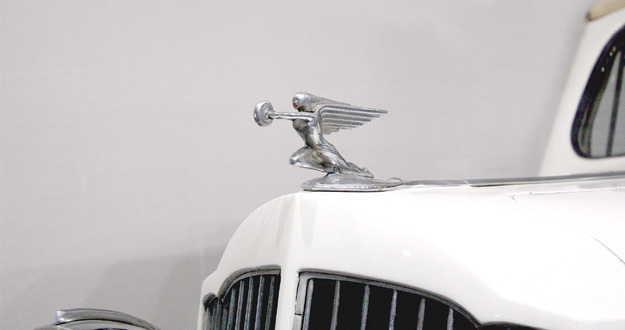
The Flying Lady: The Quaid's Packard.
Shields, mementos and gifts presented to the Quaid all reflect the love and respect that he commanded over millions of hearts from Bengal to Khyber. Also on display are beautiful items of personal use such as ivory napkin holders and a silver cigarette case. His collection of holy books includes one English translation of the Qur’an with a commentary by A Yusuf Ali bound in black hard back, much like his books of law.
Silently looking back at the visitors from a glass case, is an Imam Zamin with the Arabic text “Fi Amaan Allah” (In the safety of Allah), written with zari which has faded over the decades. The Imam Zamin contains five one Rupee coins of the state of Hyderabad. A good biographical museum should be able to transport the visitor for a brief moment into the life of the personality it is dedicated to, regardless of location or time. The “Aiwan” does just that.
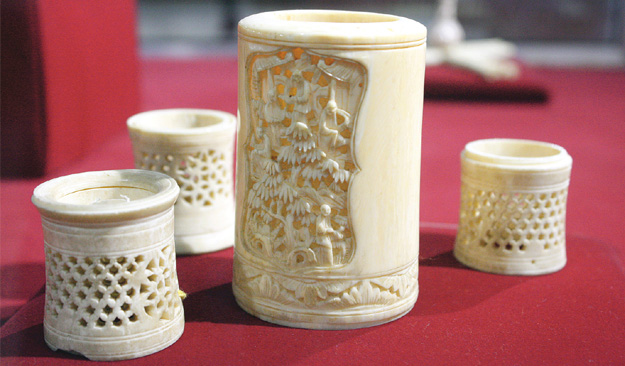
Decorative pieces carved out of ivory.
The place has a certain power. It seems as if the frail and graceful man in the black and white pictures will step out of the two-dimensional frames any minute, take a measured walk through his study, pick up a few books, select his favorite suit for the evening and move on. One has to pause and look in admiration at his collection of custom-made designer accessories ranging from engraved buttons to buckskin shoes. His wardrobe, elegant and enviable included made to order suits stitched by the finest fashion houses of London and Paris. The letters “MAJ” were embroidered on the inner side of some shirts’ collars. One handkerchief in particular caught my attention as it only had the letter “J” — just the way Ruttie Jinnah used to lovingly call him. Was it a gift from his beloved wife? We may never know. It is easy to imagine in this magical space that the fashionably dressed “J” would then be driven off in one of the two vintage sedans — his private 1938 Packard in white and the official Black 1947 Cadillac.
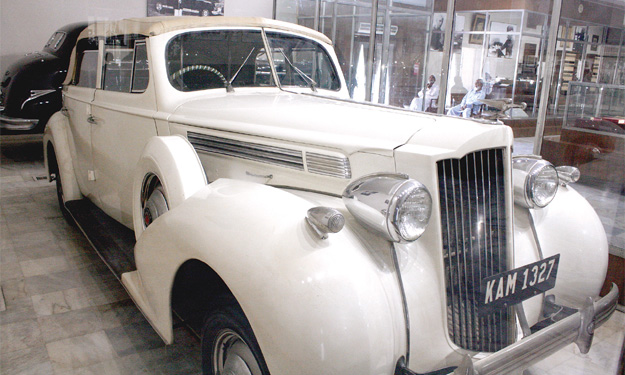
The white Packard
Perhaps Mr Jinnah would like to play golf today or else don his Jodhpur trousers and fancy a horse ride? The man certainly had great taste in fashion, books, furniture, weapons — you name it, he had it. And along with a taste and an eye for the finer things in life, he had the unshakable resolve that helped carve out a nation.
Earlier during this visit, I had come across an old Chitrali lady and her young son, looking for some change for a hundred rupee note. They exchanged currency and pleasantries with me despite their broken Urdu. Later, inside the “Aiwan”, I saw them being insolently reprimanded for attempting to take pictures. The son sheepishly pointed towards me clicking away with abandon and I felt the need to walk over to him and explain that I was permitted to do so for a press assignment. Later, I had to prove my innocence to countless others before finally succumbing to my guilt and packing away my camera altogether.
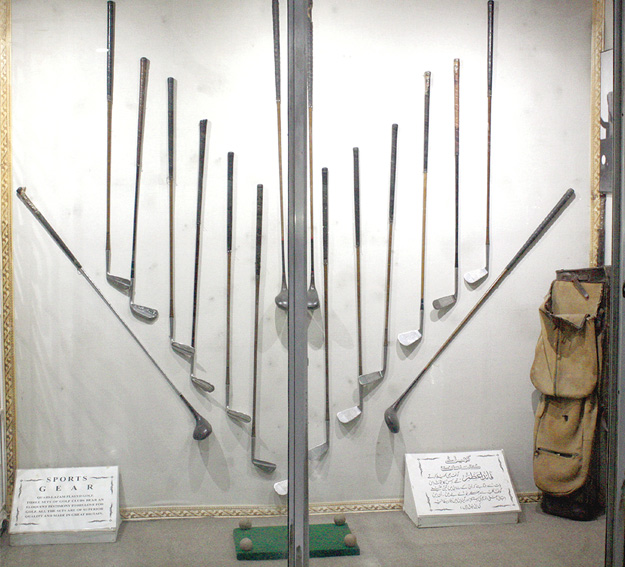
The Quaid's golf clubs
The Quaid’s personal life suffered because of his commitment to larger causes. His first wife, Emibai Jinnah, died while he was studying in the UK and little is known about her. While Ruttie “Maryam” Jinnah is relatively well known, in the midst of events leading up to partition and what followed thereafter, she too did not enjoy the undivided attention of the Quaid, nor the public spotlight she deserved. However, here in the museum, behind thick sheets of glass, the spot lights are definitely on her.
The recently deceased maestro Ardeshir Cowasjee, in a July 2000 piece, had expressed gratitude to the Zoroastrian community of Pakistan for conceiving, funding, planting “the Ruttie Jinnah Grove” and “for handing over the completed garden to the Quaid-i-Azam Mazar Managing Board in March 1999 for further and continued upkeep and maintenance”. I looked around on our little walk to the podium but was unable to locate the clump of trees dedicated to Mrs. Jinnah. With my family in tow and the mid-day heat sapping our strength, I did not search the huge mausoleum grounds. Hence, inside the museum, I was pleasantly surprised to find a window dedicated to Ruttie Jinnah, beautifully displaying some of the Quaid’s personal belongings amidst large pictures her.
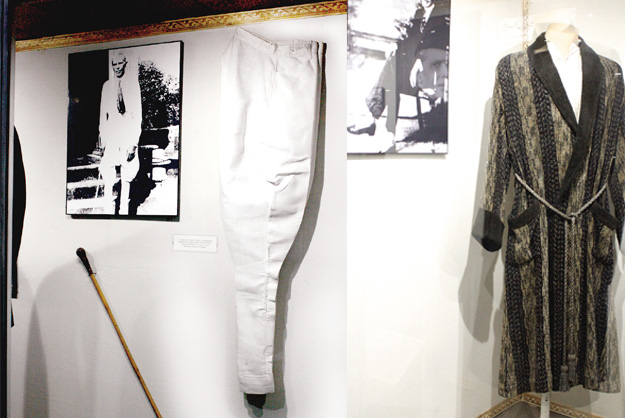
Jodhpuri pants for horseriding (L) and the dressing gown (R) for more casual moments.
Ruttie Jinnah died on February 20, 1929, on her 29th Birthday. MC Chagla who was present at the funeral, writes in his book Roses in December, “That was the only time when I found Jinnah betraying some shadow of human weakness: there were actually tears in his eyes. It was, indeed, a tragic sight to see someone so young and beautiful lying in the cold embrace of death.”

Also in the gallery are some pictures of Ms Dina Wadia, the Quaid’s only child, whom Ruttie “Maryam” Jinnah gave birth to. Ms Wadia almost shares her birthday with Pakistan, ie, the night of 14th August, though she was born after midnight and hence technically on the 15th. She married Neville Wadia, a Parsi, against Mr Jinnah’s wish, and thereafter her relationship with her father became formal to the point that the Quaid addressed her as ‘Mrs Wadia’ in correspondence and she reciprocated by calling her father ‘Mr Jinnah’.
To be Jinnah was to be knowledge, grace, class, commitment and above all sacrifice personified. Physically, the age worn designer shoes of the Quaid on display might be size 10, but the ones we have to fill, as citizens of the nation he created, are much larger.
Published in The Express Tribune, Sunday Magazine, December 23rd, 2012.
Like Express Tribune Magazine on Facebook and follow at @ETribuneMag
COMMENTS (17)
Comments are moderated and generally will be posted if they are on-topic and not abusive.
For more information, please see our Comments FAQ
1731916090-0/sabrina-(3)1731916090-0-405x300.webp)


1732020599-0/BeFunky-collage-(73)1732020599-0-165x106.webp)
1731926127-0/zayn-(1)1731926127-0-165x106.webp)

1724319076-0/Untitled-design-(5)1724319076-0-270x192.webp)










Beautifully written article. It feels if one is seeing everything along side the author. I would request Tribune to give me Mr. Adil's email, so that I can personally thank him on writing this beautiful article.
Can anyone guide me where I can get a DVD / CD of "Jinnah Sey Quaid" ? The TV play?
@Dr.A. K.Tewari
A Doctor is not needed in this case.
Absolutely fantastic write-up and awesome photographs!!
Historian R. J. Moore wrote:
"Few individuals significantly alter the course of history. Fewer still modify the map of the world. Hardly anyone can be credited with creating a nation-state. Mohammad Ali Jinnah did all three."
A mesmerizing tour of the great Quaid's tomb via beautifully drafted words.Splendid work.
Great read indeed. In fact a treat before Quaid's anniversary...
Nicely done. Thank you!
@Dr.A. K.Tewari: in your dreams mate.
The apple certainly has fallen far from the tree BUT it is up to us to roll it gently towards its intended destination. This piece certainly makes me re-think my new years' resolution!
Jinnah 's vision is before us as present days Pakistan .
@Yas Umeed: Kamal Karta pa ji !
Amazing. Great and true leaders he was. What a taste he had,no doubt he was a remarkable personality and a person who was born for bringing a nation on the world's map ( Pakistani Muslims). God created him for a nobel cause, we are waiting for another Quaid for this nation.Pray Allah can do anything.This brroken states indire needs a man like Jinnah.
Thanks and Gratitude to the writer of this article. It is very informative about a place I have never visited . About a person I have never met , I have read about quite a bit and have a lot of admiration. What I feel about Mr. Jinnah may sound some what blasphemous to some but this is how I see him. I see a great resemblance between Jinnah and Moses. Moses was successful in getting freedom for Israelites from Egyptians but could not persuade his people to claim the land Allah had given them. Mr Jinnah secured freedom for Muslims of India , got them a new country of their own but these modern day 'Israelites' could not manage it to keep it a blissful place for every citizen. They converted it into a hellish place as it is now. These people did not deserve this new country. Some other people will have to replace them to make it what Jinnah dreamed.
Brought tears to my eyes!
Loved reading your blog, thanks for the write-up.
Very classy! I've always wanted to go to the Mazar e Quaid and now I just want to go even more. Thank you so much for this.
Nicely summarized for someone like me who never visited this awesome place